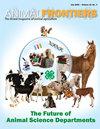猪的精准养殖
IF 3.2
2区 农林科学
Q1 AGRICULTURE, DAIRY & ANIMAL SCIENCE
引用次数: 71
摘要
为了保证在现代牲畜养殖场对单个动物进行准确和连续的监测,农民现在需要可靠和负担得起的技术来协助他们执行日常管理任务。将过程工程的原理和技术应用于畜牧业以监测、建模和管理动物生产被称为精准畜牧业(PLF)。在不久的将来,精准畜牧业似乎是唯一现实的方式,既能支持农民和牲畜生产链上的其他利益相关者,又能应对不断增长的肉类需求。尽管畜牧生产日益集约化,但精准畜牧业是一系列旨在提高农民与个体动物保持联系的能力的做法。它旨在通过观察、行为解释和控制尽可能小的动物群体,实现经济、环境和社会可持续的农业。它使农民能够降低运营成本,如饲料、药物和能源支出。此外,农民可以使用PLF技术来监测动物的健康和福利,以确保动物生活良好,没有疾病。精准畜牧业系统旨在将技术成果转化为对农民有用的信息。商用产品需要符合一定技术和安全标准的硬件与软件相结合,良好的用户界面,存储数据的备份解决方案,断电后自动重启功能,手册和帮助功能,以及能够安装和维护产品的安装人员等。由于缺乏不同学科之间的合作,PLF技术的结果和潜力对动物科学家、兽医、动物行为学家等来说大多是未知的。然而,毫无疑问,新技术与生物学的结合在实现和执行指令以及经济和社会方面为欧盟提供了巨大的机会。许多数据已经由内部控制计算机自动注册,并在农场计算机上收集。然而,在实践中,养猪户很少使用这些信息。结果,由于生产过程中的偏差没有被注意到或注意得太晚,他们错过了钱。然而,PLF面临的最大挑战是将这些不断增长的数据转化为可用的信息,以便农民全天都能直接使用相关信息来管理作业。本文章由计算机程序翻译,如有差异,请以英文原文为准。
Precision livestock farming for pigs
To guarantee accurate and continuous monitoring of individual animals at a modern livestock farm, farmers nowadays need reliable and affordable technologies to assist them in performing daily management of tasks. The application of the principles and techniques of process engineering to livestock farming to monitor, model, and manage animal production is called precision livestock farming (PLF). Precision livestock farming seems like the only realistic way to support farmers and other stakeholders in the livestock production chain in the near future while at the same time coping with the rising demand for meat. Precision livestock farming is a series of practices aimed at increasing the farmer’s ability to keep contact with individual animals despite the growing intensification of livestock production. It aims to achieve economically, environmentally, and socially sustainable farming through the observation, behavioral interpretation, and control of the smallest possible group of animals. It enables farmers to reduce operational costs such as expenditures to feed, medication, and energy. Moreover, farmers can use PLF technologies to monitor animal health and welfare to ensure that animals live well and are free of diseases. Precision livestock farming systems aim to translate the output of the technology to useful information to the farmer. Commercial products need a combination of hardware complying with certain technical and safety standards in combination with software, a good user interface, a backup solution to store data, an auto-restart function in case of power failure, manual and help functions, and installers who can install and service the product, etc. Results and potential of PLF technology are mostly unknown to animal scientists, veterinarians, ethologists, etc. due to a lack of collaboration among different disciplines. However, there is no doubt that the combination of new technologies with biology offers great opportunities for the EU in terms of realizing and implementing directives as well as in economic and social terms. A lot of data are already automatically registered by the in-house control computers and collected on a farm computer. In practice, however, the pig farmers hardly use this information. As a result, they miss out on money because deviations in the production process are not noticed or noticed too late. However, the biggest challenge with PLF is to convert this growing amount of data into usable information so that, throughout the day, the farmer can use the relevant information directly to manage operations.
求助全文
通过发布文献求助,成功后即可免费获取论文全文。
去求助
来源期刊

Animal Frontiers
Veterinary-Food Animals
CiteScore
6.50
自引率
5.60%
发文量
74
期刊介绍:
Animal Frontiers is the official journal of the following globally active professional animal science societies:
ASAS, the American Society of Animal Science
CSAS, the Canadian Society of Animal Science
EAAP, the European Federation of Animal Science
AMSA, the American Meat Science Association
These organizations are dedicated to the advancement and dissemination of science-based knowledge concerning animal agriculture. Animal Frontiers provides a novel forum for innovative and timely perspectives that have relevance to understanding the complex dynamics at work through animal agriculture. Animal Frontiers publishes discussion and position papers that present several international perspectives on the status of high-impact, global issues in animal agriculture. Every issue will explore a theme of broad and current interest within animal science and animal agriculture.
 求助内容:
求助内容: 应助结果提醒方式:
应助结果提醒方式:


